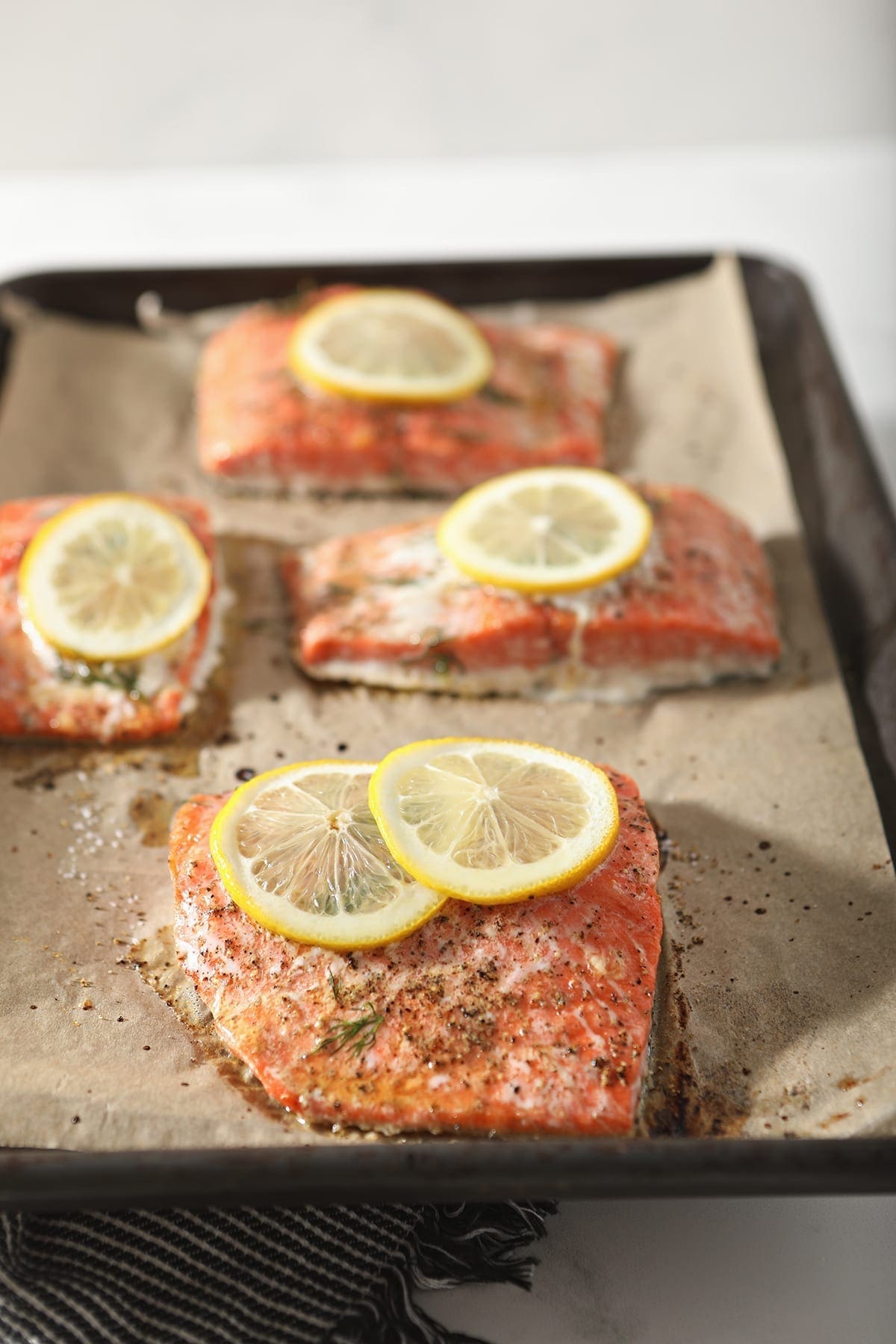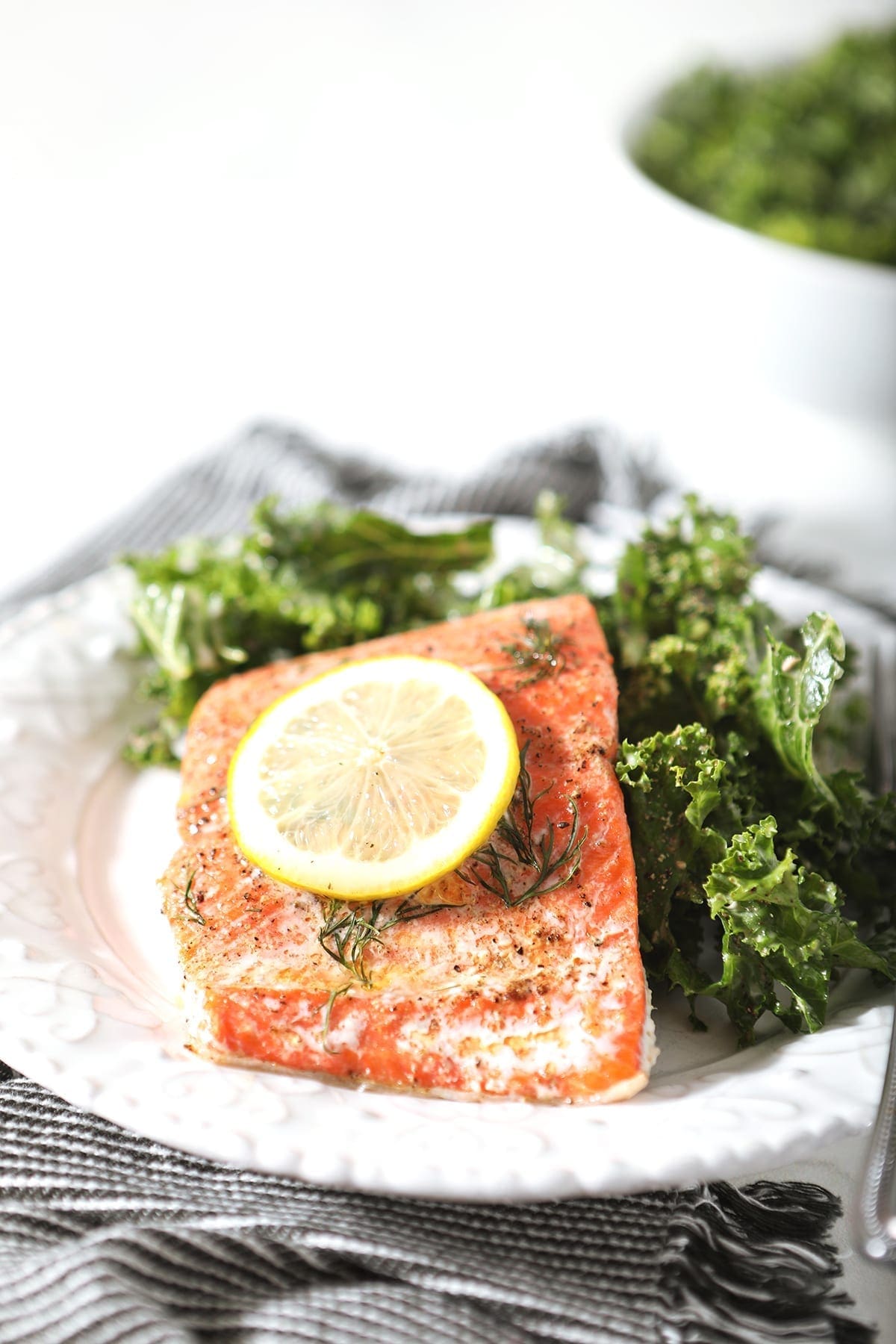Tired of overcooked, dry salmon? Learn how to bake salmon perfectly in the oven with this tutorial. Makes 4 filets, though the recipe can be halved, doubled or tripled easily.
Salmon is one of my all-time favorite fish, but I don’t like it when it’s too cooked.
So much so that there were times when I didn’t even try to do it at home because it was so annoying.
Baking salmon on parchment paper is a fantastic way to cook this healthy and delicious fish. The parchment paper helps keep the salmon moist while also preventing it from sticking to the pan. This cooking technique results in tender, flaky salmon fillets infused with flavor. Read on to learn all about how to bake salmon on parchment paper.
Why Bake Salmon on Parchment Paper?
There are several advantages to baking salmon on parchment paper:
-
Prevents sticking – Salmon has a tendency to stick to pans even when well-greased or lined with foil. Parchment paper creates a non-stick barrier so the fish lifts off easily after baking.
-
Retains moisture – The parchment paper traps steam as the salmon bakes, keeping it tender and juicy rather than dry
-
Easy cleanup – No need to scrub stuck-on bits of salmon off the pan after dinner. Just toss the parchment paper after baking.
-
Makes the flavor stronger—the salmon’s juices are reabsorbed instead of dripping into the pan. This condenses the flavor.
-
Individual portions—Parchment paper makes it easy to control how much salmon is eaten by folding up each packet neatly.
Step-By-Step Guide to Baking Salmon on Parchment
Baking salmon on parchment paper is simple to do:
Ingredients Needed:
- Salmon fillets – aim for 4-6 oz portions, skin on or off
- Parchment paper – cut into squares large enough to make packets
- Oil or butter – for brushing
- Seasonings – salt, pepper, herbs, citrus, etc.
equipment needed:
- Rimmed baking sheet
- Pastry brush
- Knife and kitchen shears
Steps:
-
Preheat oven to 400°F.
-
Fold each parchment square in half to create a crease. Open back up.
-
Place a salmon fillet on one half of the parchment paper.
-
Brush the top of the fillet with oil or melted butter.
-
Season the salmon as desired. Try fresh herbs, lemon slices, garlic, or spices.
-
Fold the parchment over the fillet. Starting at the crease, fold and crimp the edges to seal the packet.
-
Place packets seam side up on the baking sheet.
-
Bake for 10-15 minutes until the salmon flakes easily and reaches 145°F.
-
Open packets and serve salmon warm with any pan juices.
And that’s it – moist, flavorful baked salmon without any fuss or hassle! Let’s go over some cooking tips and frequently asked questions.
Baking Tips for Perfect Salmon Every Time
-
For best results, make sure salmon is dry before brushing with oil. Pat off any excess moisture with paper towels.
-
Adjust baking time based on thickness of fillets. Thinner pieces may need less time.
-
For spicier salmon, add a dash of chili flakes or paprika to the packets.
-
Try scattering chopped tomatoes, olives, spinach or other veggies into packets.
-
For easy cleanup, line baking sheet with foil and place parchment packets on top.
Frequently Asked Questions
What kind of salmon works best?
Any fresh or thawed frozen salmon fillet will work well. Go for sustainable wild-caught varieties when possible.
Does the skin need to be removed?
No, salmon skin bakes up crispy and adds flavor. You can remove it before eating if desired.
What oil should be used to brush the salmon?
Opt for an oil with a high smoke point, like avocado, grapeseed, or olive oil. Avoid vegetable and canola oil.
How long does it take to bake frozen salmon in parchment?
Increase baking time by 5 minutes or so for frozen salmon. Defrost first for shortest baking time.
Can you grill salmon in parchment paper?
Yes, parchment salmon packets can be grilled. Use a lower direct heat and watch closely to prevent burning.
Can other types of fish be cooked this way?
Absolutely! The parchment paper technique works great for delicate fish like cod, tilapia, halibut, trout, and more.
Is it safe to use parchment paper when baking?
Parchment paper is FDA approved for cooking up to 420°F. Always use new parchment for each use.
Get Creative with Your Salmon Packets
One of the great things about cooking salmon in parchment is how versatile it is. Feel free to get creative and add your own twist!
-
Compound butters – Fold herbs, citrus zest, roasted garlic into butter before brushing onto salmon.
-
Fresh veggie packets – Place sliced zucchini, bell peppers, tomatoes, and corn with salmon before folding and baking.
-
Fruit flavors – Try baking salmon with slices of orange, lemon, lime, or fresh pineapple.
-
Sauces and drizzles – Brush on teriyaki, soy sauce, hoisin, honey mustard or miso before baking.
-
Mediterranean – Stuff packets with kalamata olives, sun-dried tomatoes, feta cheese, and spinach.
-
Southwest – Mix in corn, black beans, cotija cheese, cilantro, and lime juice.
So next time you cook up some salmon fillets, give parchment paper a try. Your tastebuds will thank you for the super simple, flavorful, fuss-free technique!

Quick tips for baking salmon
- If your salmon was frozen, put it in the fridge to defrost. It’s possible to take it out of the box and let it thaw on a plate lined with paper towels.
- Use whatever herbs you have on hand. I love the taste of dill with salmon, but if you don’t have any, you can add color and flavor to the fillet with fresh rosemary, oregano, or parsley.
- If you’re having people over, put as many salmon filets as you can on the baking sheet. You can easily double this recipe and not have to change the cooking time.
- If you don’t eat dairy, use an oil with a higher smoke point, like avocado oil, to coat the salmon.
Erin’s Easy Entertaining Tips
Baked salmon looks and sounds really impressive, even if it’s a pretty quick and easy dish to make!
Don’t be intimidated by the sound of it because you can absolutely do this!
Here are a few things to do to make it easier:
- You can easily double or triple this recipe without having to cook it for longer. But keep an eye on the salmon while it bakes. How long it bakes will depend on how thick the salmon is.
- It goes well with simple side dishes that you can make ahead of time, like Spinach Madeline or a simple salad. To avoid stress while cooking a side dish at the same time, make the salmon first.

My husband spent a month in Alaska and says wild Alaskan salmon is the best. But you can use any kind of salmon in this recipe as long as you use a fillet that is about the right size.
You defrost it first, then cook as instructed in the recipe card below.
Look at the white lines that run across the salmon fillets. Poke a knife into the thickest part of the salmon and see if these lines separate easily. If they do, your fish is done. If you want to learn more about cooking salmon, I really liked this article from Bon Appetit.
This is going to depend on the thickness of your salmon. Mine took around 7 minutes and were about 1” thick. It could take anywhere between 6-9 minutes, so keep an eye on yours!.
You can use any fish you have instead of salmon if you don’t have salmon. I think this recipe would taste great with any kind of fish. Lemon and dill on any type of fish is delicious, and this process translates well. But I will say that the cook time could be different, so you will need to check that.

